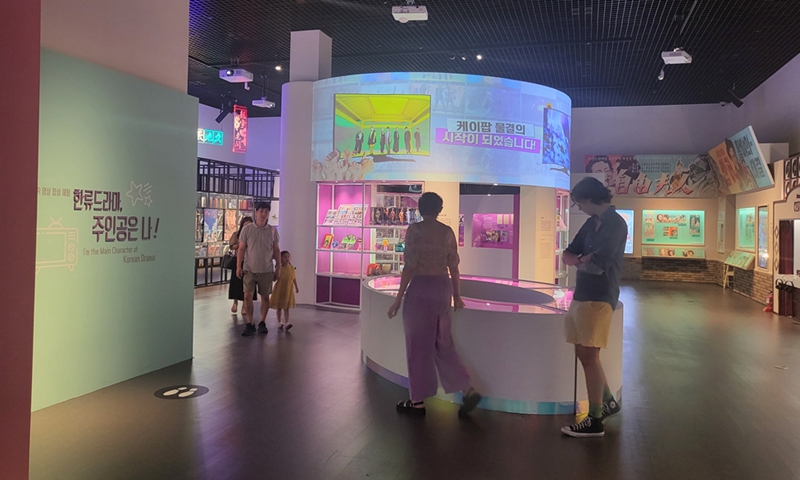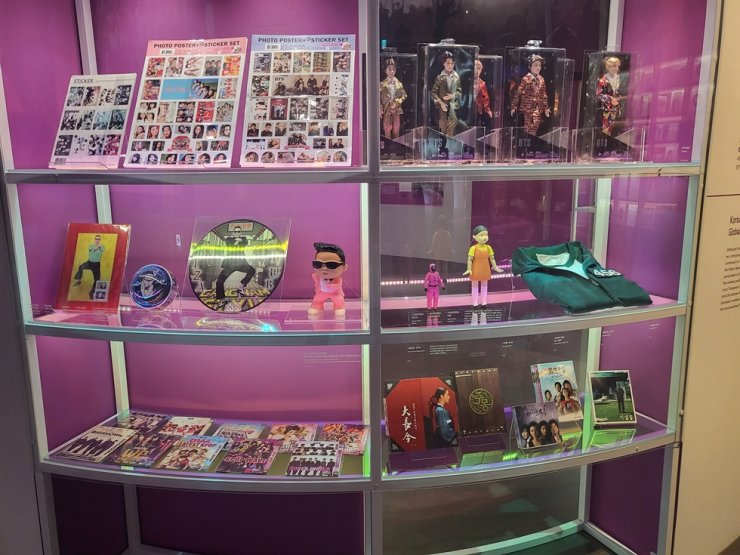
The hallyu section is placed in the center of the exhibition hall at the National Museum of Korean Contemporary History in central Seoul. Photo: Korea Times
On the third floor of the National Museum of Korean Contemporary History in central Seoul sits a cylindrical shelf filled with diverse Korean wave or "hallyu" items ranging from the figurines of K-pop juggernaut BTS to a green tracksuit featured in 2021 hit dystopian drama, "Squid Game."
These products are attention-grabbing, but they are not the only gems of "The Pop Culture We Loved and Rise of the Korean Wave" exhibition that kicked off on July 19. What sets it apart from other shows is its wise utilization of space, which visually portrays how Korea has accepted different foreign cultures to build its own legacy.
The hallyu section is placed in an open-air area in the center of the exhibition hall and is surrounded by three other sections showcasing cultural products from the US, Japan and Hong Kong Special Administrative Region, respectively. According to curator Kwon Gi-jun, the placement symbolizes openness and interconnectedness.
"Many history exhibitions display their works in chronological order to help visitors trace the history back with ease, but we focused more on showing how Korea has been affected by pop cultures of other countries and how it has managed to achieve diversity and creativity through interactions," Kwon said in a recent interview with The Korea Times held at the museum. "That is why our main hallyu section is right in the center. It has no walls or doors, and is visible from anywhere in the hall."
As he explained, the ongoing exhibition views hallyu from a transnational or global perspective.

The hallyu section at "The Pop Culture We Loved and Rise of the Korean Wave" exhibition at the National Museum of Korean Contemporary History in central Seoul, features figurines of K-pop boy group BTS, among others. Photo: Korea Times
"The Korean public has loved Hollywood movies since the nation's liberation (from Japan) in 1945 to the present day, while fads have erupted periodically for Hong Kong movies and Japanese comic books and cartoons," the museum said in an introductory guide. "Thus, ardent fans of popular culture, both inside and outside, have continued to produce new music, movies and TV shows, leading ultimately to the rise of the Korean Wave. This is a result of the inclusion and affection cultivated through an openness to various cultures amid various social conditions."
According to Kwon, the contemporary history museum decided to run its own hallyu exhibition after the Victoria and Albert Museum (V&A) in London ― one of the world's largest art and design museums founded in 1852 ― started its "Hallyu! The Korean Wave" show last year. It reportedly features some 200 items including outfits donned by K-pop girl group aespa.
"We felt the need to historicize hallyu before it's too late," Kwon noted. "In many cases, a phenomenon can be categorized as history if it lasts for more than three decades. Although not everyone agrees that this year marks the 30th anniversary of hallyu's birth, it is still a milestone year because Korea rolled out the TV series 'What Is Love' ― which is known as the first Korean drama to become a hit in China ― about 30 years ago and began exporting its cultural content."
"The Pop Culture We Loved and Rise of the Korean Wave" exhibition seeks to enrich visitors' experience by offering sessions where they can sing, dance and take pictures.
"Our goal is to entertain them," Kwon stressed. "We do not want them to navigate pop culture in a boring way. So, for this exhibition, we created different sessions that they can enjoy instead of explaining hallyu in words. One of the highlights is the 'Random Play Dance' section where visitors can dance along with K-pop fans from around the globe."
The exhibition enables visitors to walk down memory lane as well. It showcases some of the most popular cultural items in Korea during the 20th century, including "The Thriller" LP by American pop singer Michael Jackson (1958-2009), the video cassettes of Hong Kong film, "A Better Tomorrow" and the popular comic book "Mink" from Japan.
Some 30,000 people came to the exhibition in the first 16 days and quite a few of them were foreigners, Kwon added.
"Through our show, visitors from abroad can realize how their cultures have influenced hallyu and figure out ways to use it as a tool for creating a new cultural form," he said.
The curator hopes he can exhibit the online activities of hallyu fans in the future.
"Hallyu fans are very active in an online space, as evidenced by numerous K-pop cover dance videos and their activities on Twitter," he said. "I wanted to display them somehow, but could not do so this time. I considered producing a video featuring them, but could not handle some copyright issues. I hope I can make a successful attempt next time."
"The Pop Culture We Loved and Rise of the Korean Wave" exhibition is scheduled to run through Sept 3.





